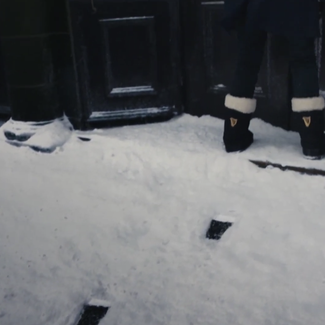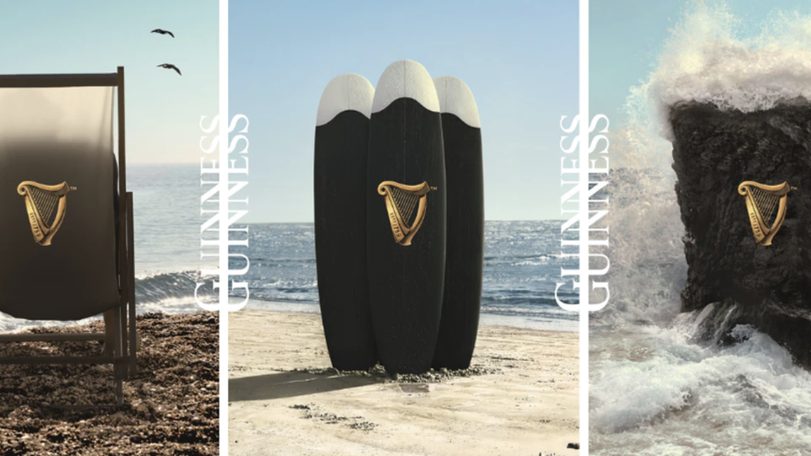
Marketing Lessons Behind Guinness’ Evolving Strategy
With the brand and agency having worked side by side for nearly three decades, Global brand director Stephen O’Kelly and AMV BBDO chief creative officer Nadja Losgott share some insights
10 July 2025
There are few brands that have ever reached the level of fandom and love as that of a pint of ‘the black stuff’ from Ireland.
For example, the fever-pitch demand for Guinness over the most recent Christmas period led to the Irish stout being completely unavailable in many parts of the UK and drove an 18 per cent increase in beer sales for parent company Diageo over the period. It is a drink that, even after 266 years, continues to find new consumers, while retaining lifelong ones as well.
It’s a brand that instills dedication and pride in those who drink it, and that desire has been engendered through classic ads that have grown its appeal the world over. It is a brand that has many lessons to share and during the most recent Cannes Lions its marketing lead and its longtime creative agency did just that.
Global brand director Stephen O’Kelly proudly describes himself as the fourth generation of his family to work for Guinness. While talking with AMV BBDO chief creative officer Nadja Losgott, the two reflected on the 27-year-old relationship between the brand and agency and the iconic creative work that have been produced during that time.
Built on Quality
Rupert Guinness, who was chairman of Guinness from 1927, said: "The quality of our advertising must be equal to the quality of the beer.”
The drinks brand only really turned to advertising at the start of the 20th Century, with the standards expected by Rupert Guinness setting the “creative ethos” that the brand continues to try and meet all these years later, believes O’Kelly.
“I'm sure Rupert would be very proud to see how Guinness is doing today, and all the incredible creativity on the brand,” he continues.
Post-World War Two, an artist called Gilroy produced iconic outdoor work for the brand featuring animals such as penguins, toucans, and even a seal balancing a pint on its nose, with the core aim of making people smile following a difficult period.
That desire connects with the work from today, claims O’Kelly, who says the team talk about having ‘a twinkle in the eye’ through intelligent advertising that contains some X-factor that consumers think ‘Only Guinness could do that’. “Not Everything Is Black and White Makes Sense” from 1997 as another example prior to the partnership with AMV.
A Platform Made of More
The partnership with AMV BBDO began in 1998, operating under the brand platform ‘Good Things Come To Those Who Wait’, which included the much-celebrated‘Surfer’ campaign as well as more recently, the ‘Made Of More’ platform.
O’Kelly has been involved in most of the campaigns under the more recent platform, from ‘Cloud’ {2012] through to 2019.
He explains that the origins of ‘Made Of More’ came as the marketing team wanted to convey Guinness as “a beer of substance” while also making it “more human” and be relatable to consumers who loved the brand. The long form of the platform is actually ‘A beer made of more for people made of more,’ he reveals. Made of More would eventually end its run in 2019 as the team looked to build a new chapter.
Described as ‘a £1bn idea’, the platform would go on to win a Gold IPA Effectiveness Award in 2020.
“A brand constantly needs to move forward,” explains Losgott. “What we realised was that we needed to take something from being fixed - always having the perfect pint and showing a perfect pint - to something more energised.”
Another revered campaign, Sapeurs’ [2014] proved to be the guiding light for how the direction of the marketing, taking a less “static” approach from ‘perfect pint’ to become more playful in how the pint was looked upon.
“It moved from a kind of straight camera angle eye view to more of a top eye view, a social eye view in the way that you see and hold a freshly poured pint… it was an interesting shift, but it was a big shift in what the advertising and all the comms looked like,” Losgott continues.
Define and Redefine Your DNA
While there was a deliberate choice to move away from what had served Guinness so well over the years to enter a new era of marketing, O’Kelly highlights the importance of also deciding what needs to stay the same. That was chosen across three key areas.
The first was ‘enduring values’, which are defined as ‘the power of ‘goodness,’ ‘communion, and power.’ These are seen to be core ingredients of how Guinness shows up through activations, content, and across culture and will never change.
However, the modern interpretation of Guinness must evolve, explains O’Kelly, to keep up with the evolution of society, consumers, and geography. For communion, the incredible community established and maintained by the brand around the world remains indelible.
Maintaining clear ideas on the brand is another brand lesson from the duo, for example, the Guinness harp on the glass and packaging has become iconic, only to be tweaked rather than revolutionised on occasion.
And then there is ‘Only Guinness Could, Only Guinness Would’, a phrase that acts as both a test and a mantra for the business ethos which underlines its aspirations, including multimillion-pound sponsorship deals such as with The Premier League in England and the Women’s Six Nations.
“We want to delight and surprise consumers with what we say and beat their expectations,” explains O’Kelly. “We're determined, whatever we do, that it will be unmistakably Guinness, and there will be our character and our values. That is serving us really well.”
Losgott adds that this strategy of forming partnerships allows things to be done in a different way and for consumers to see Guinness in different ways, for example, seeing it as a summer drink, while remaining recognizable through its distinctive key black and white key brand assets. Those, however, can also be played with – as exemplified in the responsible drinking campaign ‘Guinness Clear’, which offered drinkers a new way to order water at a bar.
“It just became an amazing joke that people would ask at the bar, even when they were embarrassed to ask for something. They actually had a joke to ask the barman for, for a glass of balls about asking them for a Guinness clear, which was very successful.
Listen To Your Superfans
This was also helpful for communications during the restrictions of the pandemic, allowing Guinness to reference a pivotal moment of reemerging from lockdowns to see that the world was still recognisable. People had missed interacting with their communities in person, and the brand saw how it could play a role in recapturing that behaviour, leading to the creation of ‘#lookslikeaguinness’.
The brand had already invested £30m in UK pubs and hospitality to ensure its survival during the months they were closed, so it was able to capture the moment of reopening, knowing it had played a big part in reaching there. It also featured the brand legacy ‘Good things come to those who wait’.
“Find your super fans,” advises O’Kelly when referring to the role of community. Having spent decades strengthening the brand through major ad campaigns, Guinness is now ready to talk to its consumers, adopting creators to help drive interaction, which is democratising its creative strategy.
This was exemplified by the brand embracing the Twitter account @shitlondonguinness, which features pictures of poorly poured pints being shared across the platform. That made the brand more proactive to ensure training was properly provided to bar staff and that pints were being served to meet expectations.
“It's given us a much more authentic voice on our policy and it’s also inspired tens of millions in investment on inequality to make sure that we have beautiful Guinness everywhere, no matter where you go,” reveals O’Kelly on the impact of the account.
Losgott adds that when a moment like that comes along for a brand, it’s natural to panic and see it as “a disaster”, especially for a brand built around the image of the perfect pint. However, it has come to be seen as “a love letter.” she believes, run and updated by Guinness lovers, while directly highlighting exactly the places the brand needs to visit to improve service.
Guinness may be a company with over 250 years of history, but its marketing and creative teams continue to look for, and embrace, the new in the world it continues to thrive within.








